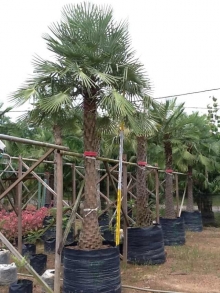
Family Name: Arecaceae
Common Name: Caranday Palm,
Caranda,
Palma Blanca
Description:
Bearing bold, fan-shaped fronds atop a stout trunk, this variable, small to large palm from Argentina, Paraguay, Bolivia, and Brazil makes a great subject for tropical and subtropical gardens.
Green to silvery fronds are borne atop the solitary trunk on long, erect, inclined, or drooping stems ("petioles"), forming a rounded crown. The fronds are divided into many stiff blade-like segments that radiate like the spokes of an umbrella. They often have waxy undersides. The petioles are edged with hooked tooth-like spines. A picturesque "skirt" of drooping dead leaves often fringes the base of the crown. Plants are initially stemless, developing a trunk after a decade or more. Trunks of young plants bristle with the protruding, wedge-shaped petiole bases of fallen leaves, in the manner of a pineapple fruit. The petiole bases eventually drop to reveal the trunk, which is typically gray with faint horizontal petiole scars. In spring or summer, dense clusters of small yellowish flowers arch beyond the leaves in branching inflorescences. The flowers are perfect, containing both mail and female parts. Small round fruits follow the flowers, ripening black in late summer or fall. Birds and bats eat the fruits.




